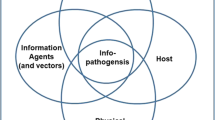Abstract
This paper is devoted to developing a system of models of information dissemination in society. As a superstructure for the base model, four new mechanisms that have an effect on information disseminating are proposed. For the model with these four mechanisms, sufficient conditions of the stability of the nonadherent state are obtained.
Similar content being viewed by others
References
A. A. Samarskii and A. P. Mikhailov, Mathematical Simulation (Fizmatlit, Moscow, 2006) [in Russian].
A. P. Mikhailov and N. V. Klyusov, “On special features of the simplest mathematical model of disseminating an information danger,” in Mathematical Simulation of Social Processes (MAKS Press, Moscow, 2002), Vol. 4, pp. 115–123.
N. A. Marevtseva, “Simplest mathematical models of information confrontation,” in Mathematical Simulation of Social Processes (MAKS Press, Moscow, 2010), Vol. 11, pp. 59–72.
N. A. Marevtseva, “Certain mathematical models of information attack and information cofrontation,” Sotsiologiya, No. 3, 26–35 (2011).
A. P. Mikhailov and K. V. Izmodenova, “On optimal control of information dissemination,” Mat. Model. 17(5), 67–76 (2005).
A. P. Mikhailov and K. V. Izmodenova, “On optimal control in mathematical model of information dissemination,” in Mathematical Simulation of Social Processes (MAKS Press, Moscow, 2004), Vol. 6.
N. A. Marevtseva, “Simplest mathematical models of information confrontation,” in Mathematical Simulation and Modern Information Technologies: Collection of Articles of All-Russian Youth Scientific Schools (Yuzhnyi Federal’nyi Univ., Rostov-on-Don, 2009), Vol. 8, pp. 354–363.
A. P. Mikhailov and N. A. Marevtseva, “Models of Information Struggle,” Mat. Model. 23(10), 19–32. (2011).
F. M. Bass, “A new product growth for model consumer durables,” Man. Sci. 15, 215–227 (1969).
L. L. Delitsyn, Quantitative Models of Innovations Dissemination in the Field of Information and Telecommunication Technologies (Mosk. Gos. Univ. Kul’t. Iskusstva, Moscow, 2009) [in Russian].
V. A. Shvedovskii, “Simulation of information dissemination in social groups,” in Matemathical Methods in Sociological Researches (Nauka, Moscow, 1981), pp. 207–214 [in Russian].
D. A. Gubanov, D. A. Novikov, and A. G. Chkhartishvili, Social Networks: Models of Information Effect, Control, and Confrontation (Fizmatlit, Moscow, 2010) [in Russian].
D. J. Daley and D. G. Kendall, “Stochastic rumors,” J. Inst. Math. Its Appl. 1, 42–55 (1964).
T. Schelling, Micromotives and Macrobehavior (Norton, New York, 1978).
A. P. Mikhailov, V. A. Shvedovskii, A. I. Maslov, and V. F. Kovalev, “Generalized model of electoral behavior and its application to studying ethnopolitical conflicts,” Mat. Model. 15(8), 39–56. (2003).
V. A. Shvedovskii and P. A. Mikhailova, “Construction of models of interacting electorates,” Mat. Model. 20(7), 107–118. (2008).
N. Rashevskii, “Two models: imitative behavior and allocation of the status,” in Mathematical Methods in Modern Bourgeois Sociology, Ed. by G.V. Osipov (Progress, Moscow, 1966), pp. 175–197.
V. A. Shvedovskii, O. V. Shvedovskii, and N. A. Tsaplin, “Mathematical model of microdynamics of a personal change,” in Mathematical Simulation of Social Processes (MAKS Press, Moscow, 2010), Vol. 11, pp. 98–131.
A. P. Petrov and N. A. Tsaplin, “Computational experiments with the model of imitative behavior,” in Mathematical Simulation of Social Processes (MAKS Press, Moscow, 2012), Vol. 14, pp. 81–91.
N. A. Marevtseva and A. N. Valiullin, “Computational experiments with the models of information confrontation,” in Mathematical Simulation of Social Processes (MAKS Press, Moscow, 2012), Vol. 14, pp. 62–80.
Author information
Authors and Affiliations
Corresponding author
Additional information
Original Russian Text © A.P. Mikhailov, A.P. Petrov, N.A. Marevtseva, I.V. Tretiakova, 2014, published in Matematicheskoe Modelirovanie, 2014, Vol. 26, No. 3, pp. 65–74.
Rights and permissions
About this article
Cite this article
Mikhailov, A.P., Petrov, A.P., Marevtseva, N.A. et al. Development of a model of information dissemination in society. Math Models Comput Simul 6, 535–541 (2014). https://doi.org/10.1134/S2070048214050093
Received:
Published:
Issue Date:
DOI: https://doi.org/10.1134/S2070048214050093




